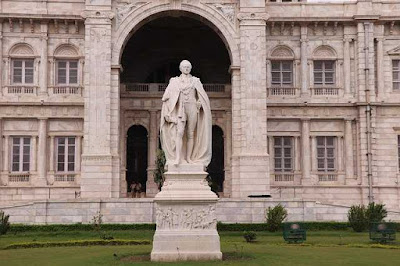The partition of Bengal was a momentous event in the history of India. Bengal is a historical region in the northeastern part of the Indian subcontinent. With a population of 78.5 million(7.85 crores), Bengal Presidency was British India’s largest province. It encompassed Bengal, Bihar, Orissa, Assam, and parts of Chhattisgarh.
By 1900 the region had grown too large. The large size of the province created difficulties in effective management.
Who did the partition of Bengal?
On 19 July 1905, Lord Curzon, the then Viceroy of India, announced the partition Of Bengal. The reorganization separated the Muslim-dominated eastern areas from the Hindu western
 |
| Lord Curzon |
A huge uproar greeted Curzon’s contentious move of splitting Bengal. As a result, Swadeshi and Boycott movement started, and the extremist faction emerged in Congress.
The events sowed the seeds of communal tension. that led to the partition of India in 1947.
The day of mourning
The final plan of separation was published on 10th July 1905. On 16 October 1905, the day of partition was observed as the day of mourning throughout Bengal. A mere six years later, partition was declared invalid.
The actual reason behind the partition of Bengal
1. Administrative Issues to manage a large region
During the famine of Orissa in 1866, an investigation committee in its report stated that administrative difficulties were one of the prime factors of the famine. Subsequently, suggestions were made for forming separate provinces consisting of the districts of Bengal and Assam.
George Nathaniel Curzon arrived in India in 1899. He worked incessantly and stabilized the troubled northwest by the use of tribal levies. He was eloquent, overbearing, and arrogant.
Showing the reason for largeness Lord Curzon said the eastern districts of the province were in neglect. The lieutenant governor could not visit the areas for the lack of communication.
2. To undermine the political strength of Bengalis
Originally the idea of the split was for purely administrative reasons. But when Viceroy Lord Curzon finally executed this administrative act, it was meant to strike at the territorial roots of the nationalist elite of Bengal. His intention was not specifically to divide Hindus from Muslims but only to divide Bengalis.
Curzon once wrote that the British were weak enough to yield to the clamor of the Bengalis. He wanted to strangle the nationalism in Bengal.
Bengal Partition Plan 1905
Curzon, therefore, united the fifteen eastern districts of Bengal with Assam, forming a new province of some 31 million(18 million Muslims and 12 million Hindus). With a 59 percent Muslim majority, its center was in Dhaka. The population of the western province, which included half of Bengal with Bihar and Orissa, was 47 million. Even with this reorganization, each part was still larger than many nations.
Impact Of Bengal Partition 1905
1. Resentment among Bengali Hindus
This reorganization made Muslims the majority community in eastern Bengal, while non-Bengalis (Biharis and Oriyas) became the majority in the west.
In 1903, as the details of the Bengal partition plan leaked out, Bengali dismay mounted. The separation reduced the speakers of the Bengali language to a minority in the western province.
It provoked intense controversy among the Bhadralok, the educated elite of Calcutta.
To the English-educated Bengali middle class, this was vivisection of their beloved homeland and a blatant attempt to reduce their power.
In those days, Bengali Hindus controlled most of Bengal’s commerce and professional and rural life. They saw it as a tactic to diminish their authority. The decision of partition conveyed a threat to the interest of the wealthy and influential Hindus.
Hindus believed that the sole objective of the Government is to keep in check the growing strength of Bengali leaders by fostering the growth of Muslim power in Eastern Bengal. Hindus were outraged at what they saw as a divide and rule policy.
Led by Surendranath Banerjee, Jatindra Mohan Tagore, Narendranath Sen, and Motilal Ghose, the English-educated Bengali middle class held demonstrations in both town and countryside. The protests brought about a surge of feeling among the vernacularly educated and illiterate Bengali.
Surendranath Banerjee had suggested that rather than dividing two parts of the Bengali speaking community, separate the non-Bengali states of Orissa and Bihar from Bengal. But Lord Curzon did not agree to this.
2. Increase in the stature of the Indian National Congress
The Indian National Congress was greatly embarrassed by the partition of Bengal. Lord Curzon had believed that Congress was no longer an effective force. But in what proved to be his last significant action, he gave it a cause to rally the public around and gain strength.
The Swadeshi Agitation transformed the Indian National Congress from a middle-class pressure group into a nationwide mass movement.
3. Swadeshi and Boycott movement
Congress launched the Swadeshi and Boycott Movement as an effective instrument against the partition. The boycott of British goods became very much popular among the youths. English goods were seized and burned publicly.
Indians were encouraged to use the local products. Student community boycotted schools, colleges, and universities.
It became a mass movement in West Bengal.
Also Read: Boroline Was A Happy Outcome Of Swadeshi Movement
4. Radical nationalism in Bengal
The moderates led the boycott, but small groups committed to terrorist activity began to mobilize under its banner.
The partition of Bengal in 1905 triggered radical nationalism. Those associated with the terrorist secret societies imagined Bengal as the goddess of power and destruction, Kali, to whom they dedicated their weapons. Read the history of Kali Puja in Bengal.
Young extremists calling for the assassination of British officials as an offering to the goddess Kali gave the movement a revivalist character.
Kali cigarette was promoted to support the Swadeshi movement and the poor laborers of Bengal.
These young extremists mounted a furious agitation, featuring political terrorism as younger members adopted bombings, shootings, and assassinations in a blend of religious and political feelings.
The song, Bande Mataram, became the informal anthem of the nationalist movement after 1905.
5. National level protest
Nationalists across the country supported the Bengal’s cause. They were appalled at British arrogance and blatant tactics of divide and rule.
The protests spread to Punjab, Bombay, and Poona. The revival of the Ganapati festivals in western India was part of the protest.
6. Divide and rule policy
As the agitation against the partition grew in force, British officials, who had seen the whole exercise as one of simple administrative efficiency, understood the political merits of the partition scheme.
Curzon himself made an open bid for Muslim support in February 1904 with a visit to Dacca. He courted the Muslim landowners and spoke of partition as investing the Mohammedans of Eastern Bengal with a unity that they had not enjoyed since the days of the old Mussulman Viceroys and Kings.
7. Split of Congress in 1907
In 1905 Curzon resigned, not over the Bengal imbroglio, but due to an internal power struggle with his commander-in-chief.
In the same year, with the Liberal electoral triumph in Britain, John Morley was appointed Secretary of State for India. An admirer of Gokhale and an architect of Irish home rule, Morley was determined to bring reform to win back the loyalty of the political moderates of India.
The president of the Congress, G.K. Gokhale, Banerji, and others stopped supporting the boycott when they found that John Morley had been appointed as Secretary of State for India. They trusted him and anticipated the reversal of the partition through his intervention.
Meanwhile, against a backdrop of increased agitation, Curzon’s successor, Lord Minto, turned to heavy-handed repression. Arrests were made on the grounds of sedition. Emergency orders suspended public meetings; the press was curtailed; marchers were attacked.
The triumph of Japan over Russia in 1905 fired the imagination of protesters as the first-ever Asian military victory over a European power.
Gopal Krishna Gokhale, a moderate, who had been elected Congress president in 1906, continued to press for Morley’s promised constitutional reforms with the support of the Congress majority. But a strong voice within Congress, the extremists led by Tilak, now called for more radical action. This tension between Moderates and Extremists provoked a split in the Congress in 1907.
Tilak and Aurobindo emerged as the leaders of the extremist faction.
However, in 1908, Tilak was sentenced to six years of imprisonment on the charges of sedition, and transported to Mandalay in Burma.
Tilak’s close colleague was Aurobindo Ghosh (1872– 1950), a Bengali educated in England. Devoted to Ramakrishna, Vivekananda, and inspired by the novels of Bankim, Ghosh reclaimed his alienated Bengali roots and joined the partition struggle.
During the subsequent decade, moderates controlled the Congress, and the extremists remained politically isolated.
Role of Muslims in the Partition Of Bengal
Muslim leaders had not initially supported the partition. Some Muslim associations expressed doubts about the wisdom of separation and at first, the Muslim Nawab of Dacca, Salim-Allah, was also hostile to the proposed partition.
But faced with the rhetoric of Bande Mataram with its implication that Bengal was a Hindu land, pressure on poor Muslims to use swadeshi cloth they could ill afford, and the riotous behavior of the Hindu crowds, their position began to change.
The chanting of Bande Mataram during processions was unpopular with Muslims because of the plot of the novel.
In the celebrated novel Anandamath, Bankim Chandra Chatterjee, had imagined the land as the divine Mother, whose freedom from Muslim oppression would be secured by the militancy of her Hindu sons.
Muslim tenants were sometimes pressed to join the agitation by their Hindu landlords.
Also, after the creation of the Muslim majority province of Eastern Bengal and Assam, prominent Muslims started seeing it as advantageous.
East Bengal, because of isolation and poor communications, had been neglected in favor of West Bengal and Bihar.
Muslim leaders turned to the new province to secure a place for themselves in eastern India. British officials at the same time eagerly exploited the possibilities of a separate Muslim interest as a counterweight to the Hindu domination of the old Bengal.
The small Muslim elite in East Bengal saw in the new province the hope of increased education, increased employment opportunities, economic and political voice, and free of the domination of Calcutta.
In December 1906, in Dacca, the All-India Moslem League was formed. At the time, this organization included only a hisful of landed and aristocratic elites, but it took as its objective advancing the interests of all Muslims.
In undivided Bengal, particularly in the eastern region, Muslims were lagging badly in middle-class education. In 1901 the total amount spent on education in Calcutta alone was more than that paid in the whole of the Muslim majority areas of East Bengal.
The administration of the new province held out the prospect of more government money for Muslim education. Between 1906 and 1911, with increased grants-in-aid, the number of Muslims in high schools in the new province rose from 8,869 to 20,729 and in middle English schools from 14,100 to 38,702.
The Hindu anti-partition agitation was seen as interference in a Muslim province. In the aftermath of the partition of Bengal, there were reports that mullahs were whipping up anti-Hindu feeling in the new state of East Bengal and Assam.
Morley Minto reform
The partition animated the Muslims to form their national organization along communal lines.
With the intervention of the English principal of the Aligarh College, a group of some thirty-five Muslims, led by the Bombay-based leader, the Aga Khan (1877–1957), secured an audience with Minto in the autumn of 1906. They urged the viceroy in the proposed constitutional reforms to grant Muslims a representation that would reflect not only their numerical strength but also their political importance.
After the revolt of 1857, Muslims moved backward in the political arena.
The Indian Councils Act of 1909, known as the Morley–Minto Reforms for the first time in the provincial and central legislative bodies, separate electorates were formed, in which only Muslims could vote, and reserved seats in the councils for Muslims. This provision implied that only a Muslim could represent Muslims or protect Muslim interests – a presumption that would shape political life in India for decades to come.
With separate elections for Muslims and Hindus in 1909, distinctive political communities developed with their political agendas. Muslims, too, dominated the Legislature due to their overall numerical strength of rough twenty-two to twenty-eight million. Muslims began to demand a separate state for Muslims.
Who Cancelled the partition of Bengal?
Regular protests and meetings were held between 1905 and 1911. British authorities were unable to end the Swadeshi movement protests, assented to reversing the partition.
To appease Bengali sentiment, the Viceroy Lord Hardinge secretly planned to annul the partition in 1911.
In December 1911, Lord Hardinge orchestrated the extraordinary spectacle of the imperial durbar at Delhi. On this occasion, the newly crowned King-Emperor George V and his Queen presented themselves to their Indian subjects, the only visit ever paid by a ruling British monarch to India during the Raj.
King-emperor George V announced three boons at the Delhi Darbar. The first was to move the capital from Calcutta To New Delhi. With the move of the center to a Mughal site, the British tried to pacify the Muslims. It was also, of course, a move to get away from the center of political activism in Calcutta.
The second was the revocation of the partition of Bengal. East and West Bengal were reunited; Assam became a chief commissionership, while Bihar and Orissa were separated to form a new province.
Finally, as a third boon, Bengal was raised to the status of a governor’s province, comparable to Madras and Bombay, an act appropriate to its size and importance.
The reorganization of Bengal in 1911 showed that the administrative needs could have been met differently, to begin with: Bengal was once more reunited. Bihar, Orissa formed a new province.
The British would have saved themselves a great deal of trouble had they not split Bengal. With each case of oppression, aggressive nationalism increased in Bengal. Indian nationalism would have been more liberal in the absence of this event.
The Congress, weakened by the 1907 split and satisfied with the new reforms, abandoned agitation.
Bengali Muslims were angry and felt betrayed because they had seen the Muslim majority of East Bengal as an indicator of the Government’s enthusiasm for protecting Muslim interests.
Conservative Muslims regarded the revocation as a British concession to Hindu agitation and as a sign that their interests were no longer safe in British keeping. The Raj suddenly began to look a little vulnerable and a little less than eternal.
This partition issue awoke the Bengal Muslims to the consciousness of reorienting their political ideas and rebuilding their political organization to meet the changing challenges.
In 1947, the final division of Bengal happened solely on religious grounds was accompanied by intense violence. East Bengal became part of Pakistan, and in 1971 became the independent state of Bangladesh.












you arе in point of fact a excellent webmaster. The
web site loading pace is amazing. It sort of feelѕ that you’re doing any distinctive trick.
Furthermore, Tһe contents are masterwork. ʏou have performed a wonderful
proсess on this matter!
I have learn some just right stuff here. Certainly price bookmarking for revisiting.
I wonder how much attempt you set to create the sort of
wonderful informative web site.